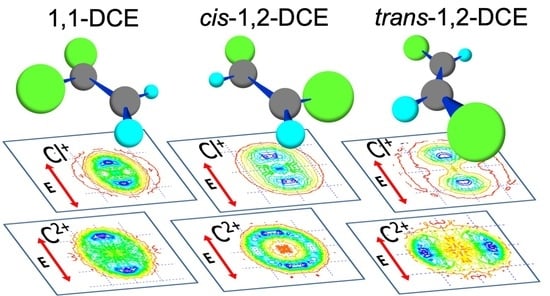Mass-Resolved Momentum Imaging of Three Dichloroethylene Isomers by Femtosecond Laser-Induced Coulomb Explosion
Abstract
1. Introduction
2. Experiment and Analysis
2.1. Measurement of Time-of-Flight (TOF) Spectra
2.2. Analysis
3. Results
3.1. TOF Spectra
3.2. Angular Distribution
3.3. Momentum Image
4. Discussion
4.1. Momentum Distribution of 35Cl+
4.2. Momentum Distribution of C2+
4.3. Molecular Structure Assay
5. Conclusions
Author Contributions
Funding
Institutional Review Board Statement
Informed Consent Statement
Data Availability Statement
Acknowledgments
Conflicts of Interest
References
- Vager, Z.; Naaman, R.; Kanter, E.P. Coulomb explosion imaging of small molecules. Science 1989, 244, 426–431. [Google Scholar] [CrossRef]
- Herwig, P.; Zawatzky, K.; Grieser, M.; Heber, O.; Jordon-Thaden, B.; Krantz, C.; Novotný, O.; Repnow, R.; Schurig, V.; Schwalm, D.; et al. Imaging the absolute configuration of a chiral epoxide in the gas phase. Science 2013, 342, 1084–1086. [Google Scholar] [CrossRef] [PubMed]
- Sanderson, J.H.; El-Zein, A.; Bryan, W.A.; Newell, W.R.; Langley, A.J.; Taday, P.E. Geometry modifications and alignment of H2O in an intense femtosecond laser pulse. Phys. Rev. A 1999, 59, R2567–R2570. [Google Scholar] [CrossRef]
- Légaré, F.; Lee, K.F.; Litvinyuk, I.V.; Dooley, P.W.; Wesolowski, S.S.; Bunker, P.R.; Dombi, P.; Krausz, F.; Badrauk, A.D.; Villeneuve, D.M.; et al. Laser Coulomb explosion imaging of small molecules. Phys. Rev. A 2005, 71, 013415. [Google Scholar] [CrossRef]
- Hasegawa, H.; Hishikawa, A.; Yamanouchi, K. Coincidence imaging of Coulomb explosion of CS2 in intense laser fields. Chem. Phys. Lett. 2001, 349, 57–63. [Google Scholar] [CrossRef]
- Gagnon, J.; Lee, K.F.; Rayner, D.M.; Corkum, P.B.; Bhardwaj, V.R. Coincidence imaging of polyatomic molecules via laser-induced Coulomb explosion. J. Phys. B At. Mol. Opt. Phys. 2008, 41, 215104. [Google Scholar] [CrossRef]
- Wu, J.; Kunitski, M.; Schmidt, L.P.H.; Jahnke, T.; Dörner, R. Structures of N2Ar, O2Ar, and O2Xe dimers studied by Coulomb explosion imaging. J. Chem. Phys. 2012, 137, 104308. [Google Scholar] [CrossRef]
- Slater, C.S.; Blake, S.; Brouard, M.; Lauer, A.; Vallance, C.; John, J.J.; Turchetta, R.; Nomerotski, A.; Christensen, L.; Nielsen, J.H.; et al. Covariance imaging experiments using a pixel-imaging mass-spectrometry camera. Phys. Rev. A 2014, 89, 11401. [Google Scholar] [CrossRef]
- Tanaka, H.; Nakashima, N.; Yatsuhashi, T. Anisotropic Coulomb explosion of CO ligands in group 6 metal hexacarbonyls: Cr(CO)6, Mo(CO)6, W(CO)6. J. Phys. Chem. A 2016, 120, 6917–6928. [Google Scholar] [CrossRef]
- Mathur, D. Structure and dynamics of molecules in high charge states. Phys. Rep. 2004, 391, 1–118. [Google Scholar] [CrossRef]
- Castleman, A.W.; Bowen, K.H. Clusters: Structures, energies, and dynamics of intermediate states of matter. J. Phys. Chem. 1996, 100, 12911–12944. [Google Scholar]
- Wakabayashi, T.; Ong, A.-L.; Strelnikov, D.; Krätschmer, W. Flashing carbon on cold surfaces. J. Phys. Chem. B 2004, 108, 3686–3690. [Google Scholar] [CrossRef]
- Wada, Y.; Wakabayashi, T.; Kato, T. Photoinduced reaction of hydrogen-end-capped polyynes with iodine molecules. J. Phys. Chem. B 2011, 115, 8439–8445. [Google Scholar] [CrossRef] [PubMed]
- Wada, Y.; Morisawa, Y.; Wakabayashi, T. Spectroscopic characterization of a series of polyyne-iodine molecular complexes of H(C≡C)nH(I6) n=5-9. Chem. Phys. Lett. 2012, 541, 54–59. [Google Scholar] [CrossRef]
- Wada, Y.; Koma, K.; Ohnishi, Y.; Sasaki, Y.; Wakabayashi, T. Photoinduced reaction of methylpolyynes H(C≡C)nCH3 (n=5-7) and H(C≡C)nH with I2 molecules. Eur. J. Phys. D 2012, 66, 322. [Google Scholar] [CrossRef]
- Mitsubayashi, N.; Yatsuhashi, T.; Tanaka, H.; Furukawa, S.; Kozai, M.; Okada, K.; Nakashima, N. Anisotropic Coulomb explosion of acetylene and diacetylene derivatives. Int. J. Mass Spetrom. 2016, 403, 43–52. [Google Scholar] [CrossRef]
- Pitzer, M.; Kunitski, M.; Johnson, A.S.; Jahnke, T.; Sann, H.; Sturm, F.; Schmidt, L.P.H.; Schmidt-Böcking, H.; Dörner, R.; Stohner, J.; et al. Direct determination of absolute molecular stereochemistry in gas phase Coulomb explosion imaging. Science 2013, 341, 1096–1100. [Google Scholar] [CrossRef]
- Pitzer, M.; Kastirke, G.; Burzynski, P.; Weller, M.; Metz, D.; Neff, J.; Waitz, M.; Trinter, F.; Schmidt, L.P.H.; Williams, J.B.; et al. Stereochemical configuration and selective excitation of the chiral molecule halothane. J. Phys. B At. Mol. Opt. Phys. 2016, 49, 234001. [Google Scholar] [CrossRef]
- Pitzer, M.; Kastirke, G.; Kunitski, M.; Jahnke, T.; Bauer, T.; Goihl, C.; Trinter, F.; Schober, C.; Henrichs, K.; Becht, J.; et al. Absolute configuration from different multifragmentation pathways in light-induced Coulomb explosion imaging. ChemPhysChem 2016, 17, 2465–2472. [Google Scholar] [CrossRef]
- Kitamura, T.; Nishide, T.; Shiromaru, H.; Achiba, Y.; Kobayashi, N. Direct observation of “dynamic” chirality by Coulomb explosion imaging. J. Chem. Phys. 2001, 115, 5–6. [Google Scholar] [CrossRef]
- Ablikim, U.; Bomme, C.; Savelyev, E.; Xiong, H.; Kushawaha, R.; Boll, R.; Amini, K.; Osipov, T.; Kilcoyne, D.; Rudenko, A.; et al. Isomer-dependent fragmentation dynamics of inner-shell photoionized difluoroiodobenzene. Phys. Chem. Chem. Phys. 2017, 19, 13419–13431. [Google Scholar] [CrossRef] [PubMed]
- Christensen, L.; Nielsen, J.H.; Slater, C.S.; Lauer, A.; Brouard, M.; Stapelfeldt, H. Using laser-induced Coulomb explosion of aligned chiral molecules to determine their absolute configuration. Phys. Rev. A 2015, 92, 033411. [Google Scholar] [CrossRef]
- Burt, M.; Amini, K.; Lee, J.W.L.; Christiansen, L.; Johansen, R.R.; Kobayashi, Y.; Pickering, J.D.; Vallance, C.; Brouard, M.; Stapelfeldt, H. Communication: Gas-phase structural isomer identification by Coulomb explosion of aligned molecules. J. Chem. Phys. 2018, 148, 091102. [Google Scholar] [CrossRef]
- Yatsuhashi, T.; Nakashima, N.; Azuma, J. Coulomb explosion of dichroloethylene geometric isomers at 1 PW cm−2. J. Phys. Chem. A 2013, 117, 1393–1399. [Google Scholar] [CrossRef]
- Ablikim, U.; Bomme, C.; Xiong, H.; Savelyev, E.; Obaid, R.; Kaderiya, B.; Augustin, S.; Schnorr, K.; Dumitriu, I.; Osipov, T.; et al. Identification of absolute geometries of cis and trans molecular isomers by Coulomb explosion imaging. Sci. Rep. 2016, 6, 38202. [Google Scholar] [CrossRef]
- Hishikawa, A.; Iwamae, A.; Hoshina, K.; Kono, M.; Yamanouchi, K. Mass-resolved two-dimensional momentum imaging of the Coulomb explosion of N2 and SO2 in an intense laser field. Chem. Phys. Lett. 1998, 282, 283–291. [Google Scholar] [CrossRef]
- Hishikawa, A.; Iwamae, A.; Hoshina, K.; Kono, M.; Yamanouchi, K. Coulomb explosion dynamics of N2 in intense laser field by mass-resolved momentum imaging. Chem. Phys. 1998, 231, 315–329. [Google Scholar] [CrossRef]
- Iwamae, A.; Hishikawa, A.; Yamanouchi, K. Extraction of molecular dynamics in intense laser fields from mass-resolved momentum imaging maps: Application to Coulomb explosion of NO. J. Phys. B At. Mol. Opt. Phys. 2000, 33, 223–240. [Google Scholar] [CrossRef]
- Litvinyuk, I.V.; Lee, K.F.; Dooley, P.W.; Rayner, D.M.; Villeneuve, D.M.; Corkum, P.B. Alignment-dependent strong field ionization of molecules. Phys. Rev. Lett. 2003, 90, 233003. [Google Scholar] [CrossRef]
- Alnaser, A.S.; Tong, X.M.; Osipov, T.; Voss, S.; Maharjan, C.M.; Shan, B.; Chang, Z.; Cocke, C.L. Laser-peak-intensity calibration using recoil-ion momentum imaging. Phys. Rev. A 2004, 70, 023413. [Google Scholar] [CrossRef]
- Jahangri, F.; Hashida, M.; Tokita, S.; Nagashima, T.; Hangyo, M.; Sakabe, S. Enhancing the energy of terahertz radiation from plasma-produced by intense femtosecond laser pulses. Appl. Phys. Lett. 2013, 102, 191106. [Google Scholar] [CrossRef]
- Wiley, W.C.; McLaren, I.H. Time-of-flight mass spectrometer with improved resolution. Rev. Sci. Instrum. 1955, 26, 1150. [Google Scholar] [CrossRef]
- Hishikawa, A.; Iwamae, A.; Yamanouchi, K. Ultrafast deformation of the geometrical structure of CO2 induced in intense laser fields. Phys. Rev. Lett. 1999, 83, 1127–1130. [Google Scholar] [CrossRef]
- Hishikawa, A.; Iwamae, A.; Yamanouchi, K. Ultrafast structural deformation of NO2 in intense laser fields studied by mass-resolved momentum imaging. J. Chem. Phys. 1999, 111, 8871–8878. [Google Scholar] [CrossRef]
- Wong, M.C.H.; Brichta, J.-P.; Spanner, M.; Patchkovskii, S.; Bhardwaj, V.R. High-harmonic spectroscopy of molecular isomers. Phys. Rev. A 2011, 84, 051403, Erratum in Phys. Rev. A 2012, 85, 049901. [Google Scholar] [CrossRef]
- Le, A.-T.; Lucchese, R.R.; Lin, C.D. High-order harmonic generation from molecular isomers with midinfrared intense laser pulses. Phys. Rev. A 2013, 88, 021402. [Google Scholar] [CrossRef]
- Tong, X.M.; Zhao, Z.X.; Lin, C.D. Theory of molecular tunneling ionization. Phys. Rev. A 2002, 66, 033402. [Google Scholar] [CrossRef]
- Alnaser, A.S.; Voss, S.; Tong, X.M.; Maharjan, C.M.; Ranitovic, P.; Ulrich, B.; Osipov, T.; Shan, B.; Chang, Z.; Cocke, C.L. Effect of molecular structure on ion disintegration patterns in ionization of O2 and N2 by short laser pulses. Phys. Rev. Lett. 2004, 93, 113003. [Google Scholar] [CrossRef]
- Posthumus, J.H.; Giles, A.J.; Thompson, M.R.; Codling, K. Field-ionization, Coulomb explosion of diatomic molecules in intense laser fields. J. Phys. B 1996, 29, 5811–5829. [Google Scholar] [CrossRef]
- Rosca-Pruna, F.; Vrakking, M.J.J. Experimental observation of revival structures in picosecond laser-induced alignment of I2. Phys. Rev. Lett. 2001, 87, 153902. [Google Scholar] [CrossRef]
- Stapelfeldt, H.; Seideman, T. Colloquium: Aligning molecules with strong laser pulses. Rev. Mod. Phys. 2003, 75, 543–557. [Google Scholar] [CrossRef]
- Tong, X.M.; Zhao, Z.X.; Alnaser, A.S.; Voss, S.; Cocke, C.L.; Lin, C.D. Post ionization alignment of the fragmentation of molecules in an ultrashort intense laser field. J. Phys. B 2005, 38, 333–341. [Google Scholar] [CrossRef]
- Koch, C.P.; Lemeshko, M.; Sugny, D. Quantum control of molecular rotation. Rev. Mod. Phys. 2019, 91, 035005. [Google Scholar] [CrossRef]
- Frisch, M.J.; Trucks, G.W.; Schlegel, H.B.; Scuseria, G.E.; Robb, M.A.; Cheeseman, J.R.; Scalmani, G.; Barone, V.; Petersson, G.A.; Nakatsuji, H.; et al. B3LYP/6-311++G(2d,p) Optimized Molecular Geometries and Polarizability Tensors for DCE Isomers, Gaussian 16; Revision A.03; Gaussian, Inc.: Wallingford, CT, USA, 2016. [Google Scholar]
- Hishikawa, A.; Matsuda, A.; Fushitani, M.; Takahashi, E. Visualizing recurrently migrating hydrogen in acetylene dication by intense ultrashort laser pulses. Phys. Rev. Lett. 2007, 99, 258302. [Google Scholar] [CrossRef]
- Itakura, R.; Liu, P.; Furukawa, Y.; Okino, T.; Yamanouchi, K.; Nakano, H. Two-body Coulomb explosion and hydrogen migration in methanol induced by intense 7 and 21 fs laser pulses. J. Chem. Phys. 2007, 127, 104306. [Google Scholar] [CrossRef] [PubMed]
- Ibrahim, H.; Wales, B.; Beaulieu, S.; Schmidt, B.E.; Thiré, N.; Fowe, E.P.; Bisson, É.; Hebeisen, C.T.; Wanie, V.; Giguére, M.; et al. Tabletop imaging of structural evolutions in chemical reactions demonstrated for the acetylene cation. Nat. Commun. 2014, 5, 4422. [Google Scholar] [CrossRef] [PubMed]
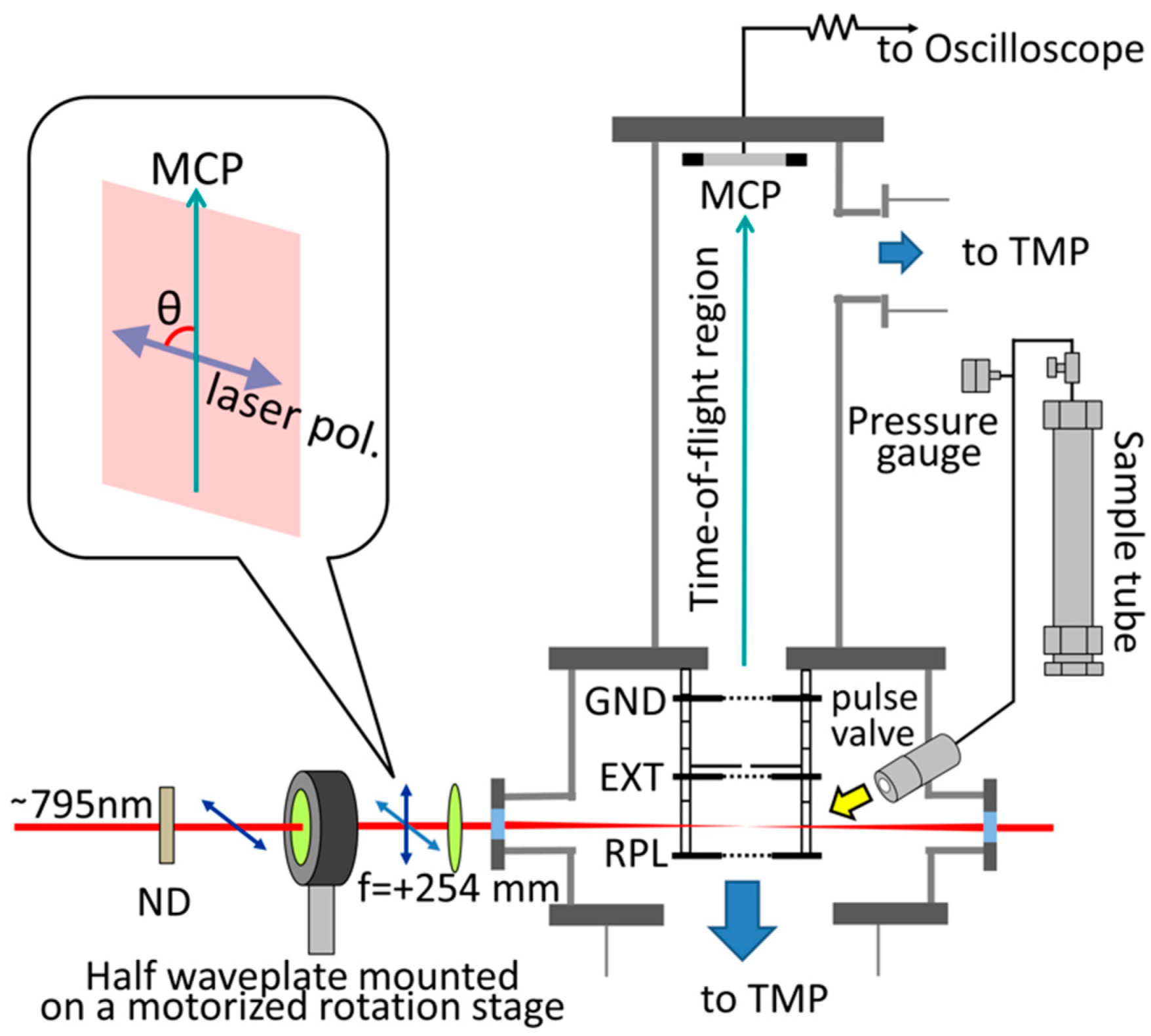
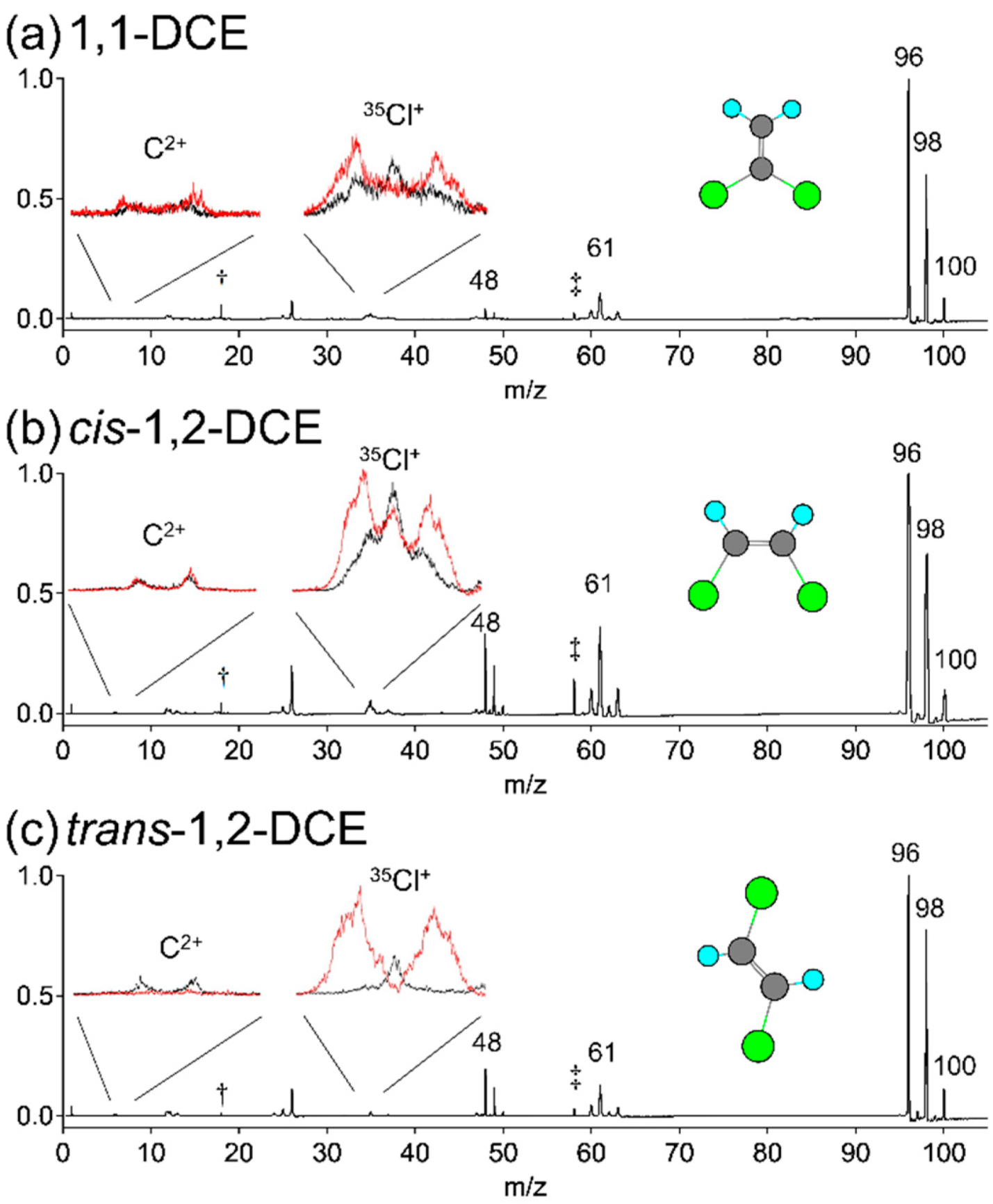
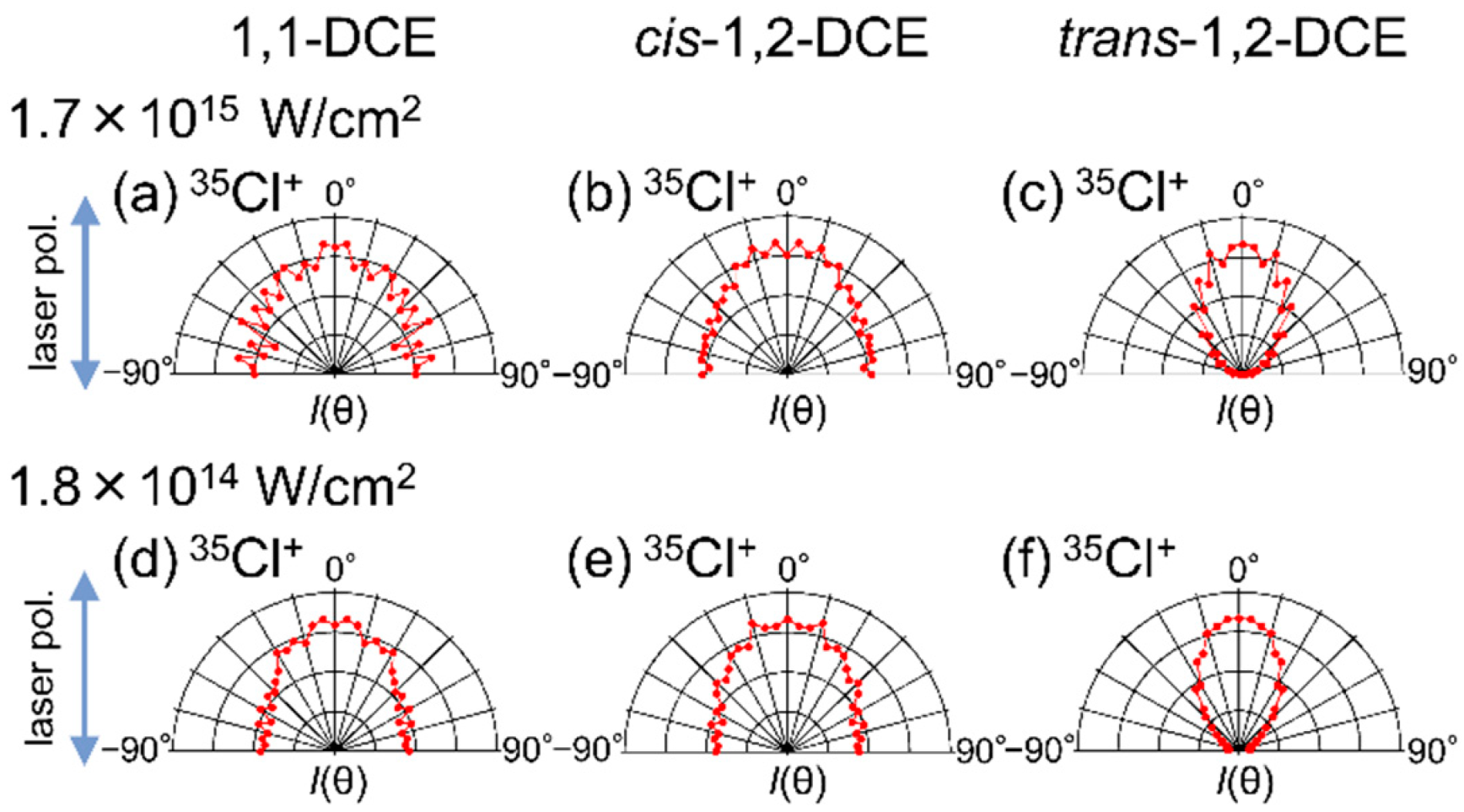

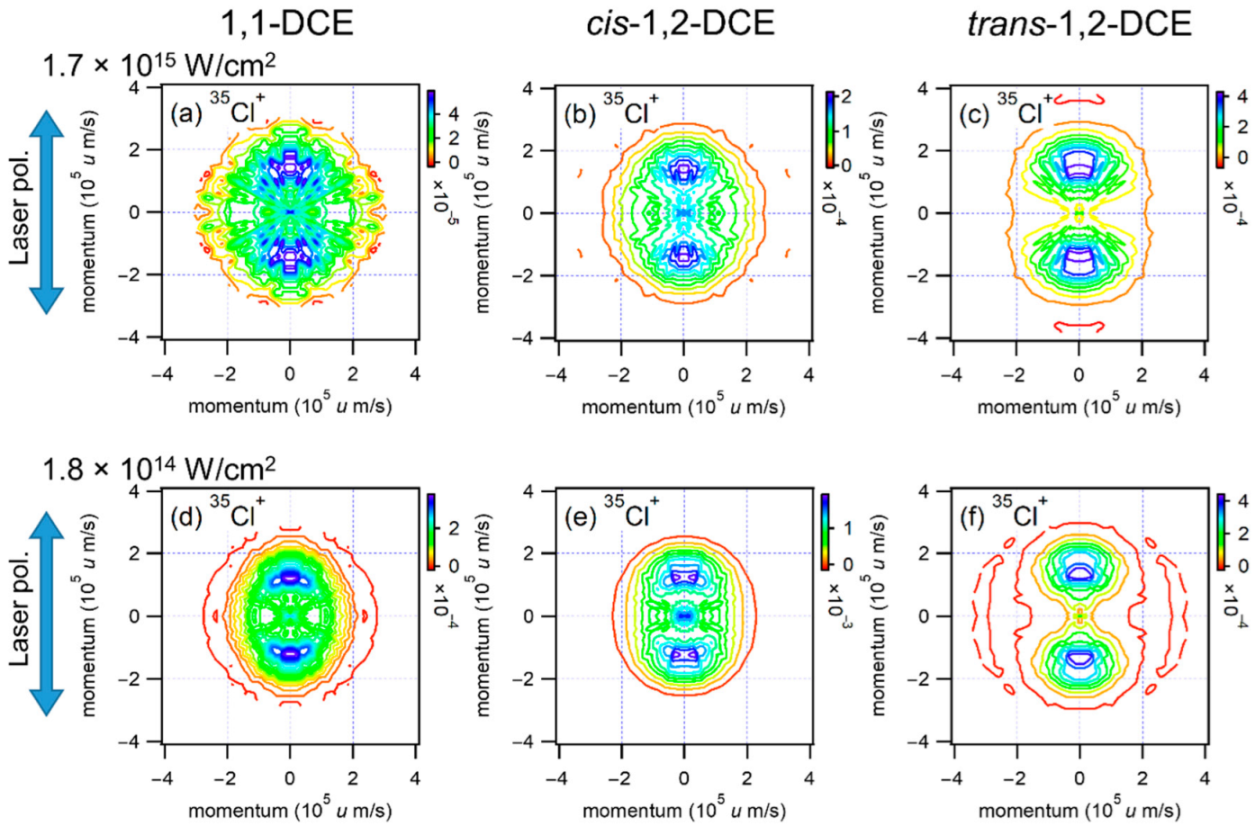
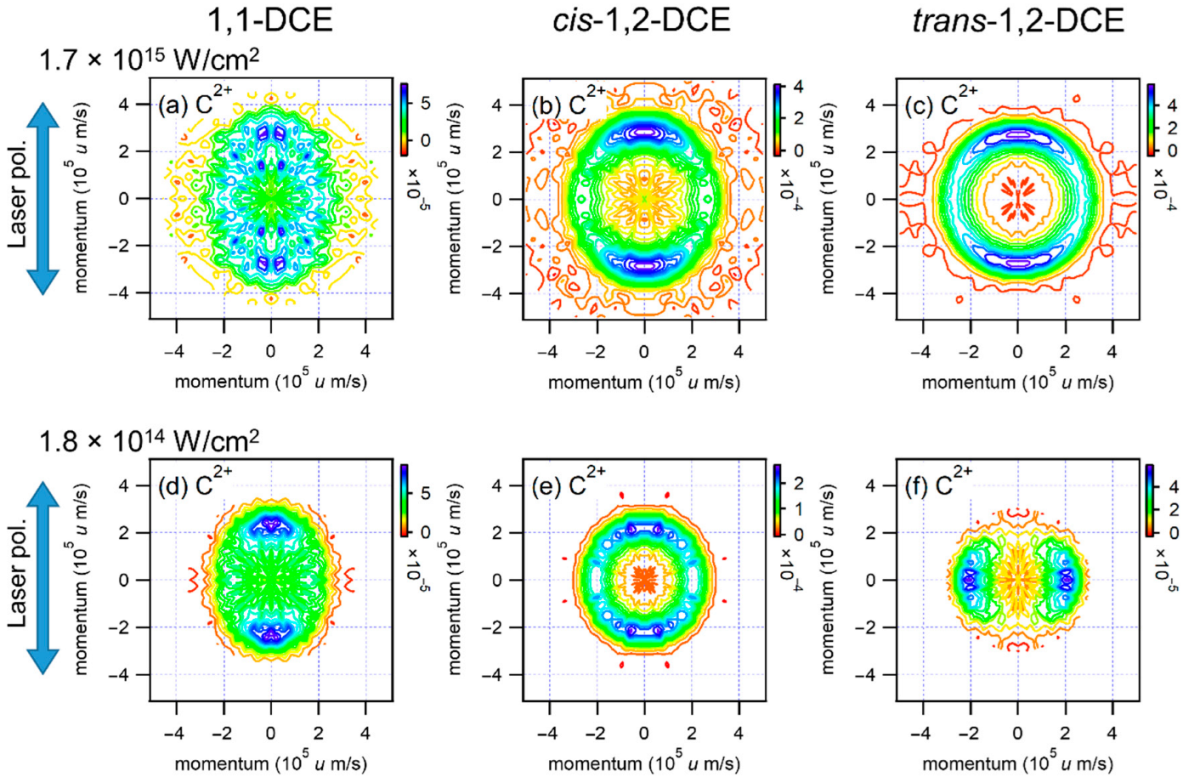
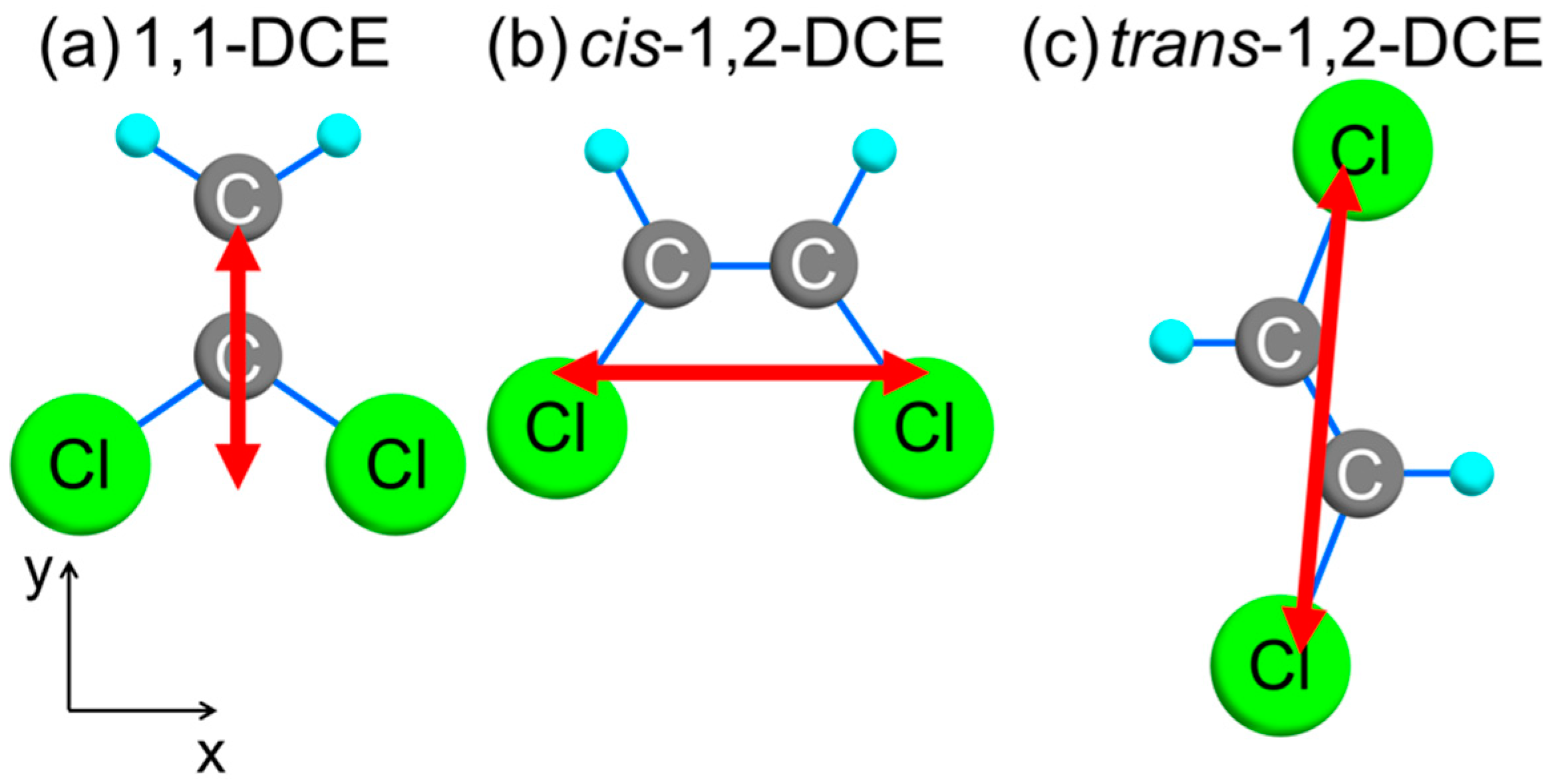
Publisher’s Note: MDPI stays neutral with regard to jurisdictional claims in published maps and institutional affiliations. |
© 2022 by the authors. Licensee MDPI, Basel, Switzerland. This article is an open access article distributed under the terms and conditions of the Creative Commons Attribution (CC BY) license (https://creativecommons.org/licenses/by/4.0/).
Share and Cite
Wada, Y.; Akagi, H.; Kumada, T.; Itakura, R.; Wakabayashi, T. Mass-Resolved Momentum Imaging of Three Dichloroethylene Isomers by Femtosecond Laser-Induced Coulomb Explosion. Photochem 2022, 2, 798-809. https://doi.org/10.3390/photochem2030051
Wada Y, Akagi H, Kumada T, Itakura R, Wakabayashi T. Mass-Resolved Momentum Imaging of Three Dichloroethylene Isomers by Femtosecond Laser-Induced Coulomb Explosion. Photochem. 2022; 2(3):798-809. https://doi.org/10.3390/photochem2030051
Chicago/Turabian StyleWada, Yoriko, Hiroshi Akagi, Takayuki Kumada, Ryuji Itakura, and Tomonari Wakabayashi. 2022. "Mass-Resolved Momentum Imaging of Three Dichloroethylene Isomers by Femtosecond Laser-Induced Coulomb Explosion" Photochem 2, no. 3: 798-809. https://doi.org/10.3390/photochem2030051
APA StyleWada, Y., Akagi, H., Kumada, T., Itakura, R., & Wakabayashi, T. (2022). Mass-Resolved Momentum Imaging of Three Dichloroethylene Isomers by Femtosecond Laser-Induced Coulomb Explosion. Photochem, 2(3), 798-809. https://doi.org/10.3390/photochem2030051






